Prices advertised based on Saver Fares.
Black Friday Message
test
Want to add a hotel stay or change your flights?
Just call our team of cruise specialists to help build your dream cruise holiday today!






Prices advertised based on Saver Fares.
Black Friday Message
test
|
|
|
| CRUISE ONLY | WAS £11879 pp £11202 PP |
| FLY CRUISE | WAS £12189 pp £11503 PP |
|
Prices based on 2 people sharing. Cruise only price does not include flights. Fly-cruise price may vary by chosen UK airport.
Where solo or family pricing is not available please call for more details.
|
|
|
|
|
| CRUISE ONLY | WAS £14079 pp £12803 PP |
| FLY CRUISE | WAS £14389 pp £13103 PP |
|
Prices based on 2 people sharing. Cruise only price does not include flights. Fly-cruise price may vary by chosen UK airport.
Where solo or family pricing is not available please call for more details.
|
|
|
|
|
| CRUISE ONLY | WAS £17169 pp £16188 PP |
| FLY CRUISE | WAS £17479 pp £16489 PP |
|
Prices based on 2 people sharing. Cruise only price does not include flights. Fly-cruise price may vary by chosen UK airport.
Where solo or family pricing is not available please call for more details.
|
|
|
|
|
| CRUISE ONLY | WAS £58269 pp £34919 PP |
| FLY CRUISE | WAS £58579 pp £35219 PP |
|
Prices based on 2 people sharing. Cruise only price does not include flights. Fly-cruise price may vary by chosen UK airport.
Where solo or family pricing is not available please call for more details.
|
|
Want to add a hotel stay or change your flights?
Just call our team of cruise specialists to help build your dream cruise holiday today!
(Prices correct as of today’s date, are updated daily, are subject to change and represent genuine availability at time of update).
Cruise only holidays are financially protected by ABTA. Fly cruise holidays are financially protected by Cunard Line under ATOL number 6294
Please click here to check the essential travel requirements before booking this cruise.
Hamburg is Germany’s second-largest city with a history dating back to Charlemagne. A major port, this vibrant city is home to art and culture, extensive shopping facilities, Baroque buildings and waterfront vistas. With its well-known fish market, art galleries and Museums together with several beautiful parks including a botanical garden, this is a city with something for everyone. British visitors who remember the Swinging Sixties may like to visit the streets around Grosse Freiheit, where an unknown pop group called The Beatles gave their first public performances in various local clubs before achieving worldwide fame.
Amsterdam combines the unrivaled beauty of the 17th-century Golden Age city center with plenty of museums and art of the highest order, not to mention a remarkably laid-back atmosphere. It all comes together to make this one of the world's most appealing and offbeat metropolises in the world. Built on a latticework of concentric canals like an aquatic rainbow, Amsterdam is known as the City of Canals—but it's no Venice, content to live on moonlight serenades and former glory. Quite the contrary: on nearly every street here you'll find old and new side by side—quiet corners where time seems to be holding its breath next to streets like neon-lit Kalverstraat, and Red Light ladies strutting by the city's oldest church. Indeed, Amsterdam has as many lovely facets as a 40-carat diamond polished by one of the city's gem cutters. It's certainly a metropolis, but a rather small and very accessible one. Locals tend to refer to it as a big village, albeit one that happens to pack the cultural wallop of a major world destination. There are scores of concerts every day, numerous museums, summertime festivals, and, of course, a legendary year-round party scene. It's pretty much impossible to resist Amsterdam's charms. With 7,000 registered monuments, most of which began as the residences and warehouses of humble merchants, set on 160 man-made canals, and traversed by 1,500 or so bridges, Amsterdam has the largest historical inner city in Europe. Its famous circle of waterways, the grachtengordel, was a 17th-century urban expansion plan for the rich and is a lasting testament to the city’s Golden Age. This town is endearing because of its kinder, gentler nature—but a reputation for championing sex, drugs, and rock ’n’ roll does not alone account for Amsterdam's being one of the most popular destinations in Europe: consider that within a single square mile the city harbors some of the greatest achievements in Western art, from Rembrandt to Van Gogh. Not to mention that this is one of Europe's great walking cities, with so many of its treasures in the untouted details: tiny alleyways barely visible on the map, hidden garden courtyards, shop windows, floating houseboats, hidden hofjes(courtyards with almshouses), sudden vistas of church spires, and gabled roofs that look like so many unframed paintings. And don’t forget that the joy lies in details: elaborate gables and witty gable stones denoting the trade of a previous owner. Keep in mind that those XXX symbols you see all over town are not a mark of the city's triple-X reputation. They're part of Amsterdam's official coat of arms—three St. Andrew's crosses, believed to represent the three dangers that have traditionally plagued the city: flood, fire, and pestilence. The coat's motto ("Valiant, determined, compassionate") was introduced in 1947 by Queen Wilhelmina in remembrance of the 1941 February Strike in Amsterdam—the first time in Europe that non-Jewish people protested against the persecution of Jews by the Nazi regime.
Rotterdam is a city that's a long way removed from most people's stereotypical notion of the Netherlands. There are few, if any, canals to be found here nor are there any quaint windmills. There is, however, a thriving modern city which is one of the busiest ports in the entire world.
In 1895 work began to construct a new seaport and harbour next to the tiny village of Zeebrugge, situated on the North Sea coast. Today the fast-expanding port of Zeebrugge is one of the busiest in Europe and its marina is Belgium’s most important fishing port. Many attempts were made to destroy this important port during both World Wars. Zeebrugge is ideally located for discovering the historic city of Bruges, and delightful seaside resorts with long sandy beaches can be visited by using the trams that run the whole length of the Belgian coast. Please note that no food may be taken ashore in Belgium. We shall not be offering shuttle buses to Bruges, but you may visit the city on an optional excursion: those visiting Bruges should note that there may be quite a long walk from the coach to the town centre.


Lying near the head of Southampton Water, a peninsula between the estuaries of the Rivers Test and Itchen, Southampton is Britain’s largest cruise port. It has been one of England’s major ports since the Middle Ages, when it exported wool and hides from the hinterland and imported wine from Bordeaux. The city suffered heavy damage during World War Two and as a result the centre has been extensively rebuilt, but there are still some interesting medieval buildings including the Bargate, one of the finest city gatehouses in England.
Widely known for the Kennedy Space Center, Port Canaveral is located in the city of Cape Canaveral, home to beautiful beaches and Brevard Zoo.
Like many southeast Florida neighbors, Fort Lauderdale has long been revitalizing. In a state where gaudy tourist zones often stand aloof from workaday downtowns, Fort Lauderdale exhibits consistency at both ends of the 2-mile Las Olas corridor. The sparkling look results from upgrades both downtown and on the beachfront. Matching the downtown's innovative arts district, cafés, and boutiques is an equally inventive beach area, with hotels, cafés, and shops facing an undeveloped shoreline, and new resort-style hotels replacing faded icons of yesteryear. Despite wariness of pretentious overdevelopment, city leaders have allowed a striking number of glittering high-rises. Nostalgic locals and frequent visitors fret over the diminishing vision of sailboats bobbing in waters near downtown; however, Fort Lauderdale remains the yachting capital of the world, and the water toys don’t seem to be going anywhere.
Just 7 miles (11 km) long and a little more than 1 mile (1½ km) wide, this island, the capital and seat of the Turks and Caicos government, has been a longtime favorite destination for divers eager to explore the 7,000-foot-deep pristine coral walls that drop down only 300 yards out to sea. On shore, the tiny, quiet island is home to white-sand beaches, the National Museum, and a small population of wild horses and donkeys, which leisurely meander past the white-walled courtyards, pretty churches, and bougainvillea-covered colonial inns on their daily commute into town. But things aren't entirely sleepy: a cruise-ship complex at the southern end of the island brings about 600,000 visitors per year. That said, the dock is self-contained and is about 3 miles (5 km) from the tranquil, small hotels of Cockburn Town, Pillory Beach, and the Ridge and far from most of the western-shore dive sites. Pristine beaches with vistas of turquoise waters, small local settlements, historic ruins, and native flora and fauna are among the sights on Grand Turk. Fewer than 4,000 people live on this 7½-square-mile (19-square-km) island, and it's hard to get lost, as there aren't many roads.
Located beside the island’s only natural harbour, the capital of Barbados combines modern and colonial architecture with glorious palm tree-lined beaches and a number of historical attractions. Experience the relaxed culture of the city renowned for its British-style parliament buildings and vibrant beach life, and seek out the Anglican church and the 19th-century Barbados Garrison. The distance between the ship and your tour vehicle may vary. This distance is not included in the excursion grades.
Called the "City of Light," Fortaleza claims that the sun shines on it 2,800 hours a year. And it's a good thing, too, as the coastline stretches far beyond the city. To the east, along the Litoral Leste or the Costa Sol Nascente (Sunrise Coast) are many fishing villages. To the west, along the Litoral Oeste or the Costa Sol Poente (Sunset Coast), there are pristine stretches of sand. The shores here are cooled by constant breezes and lapped by waters with an average temperature of 24°C (72°F).Today Fortaleza, a large, modern state capital with more than 2 million inhabitants, is Brazil's fifth-largest city. It's also on the move, with one of the country's newest airports, a modern convention center, a huge cultural center with a planetarium, large shopping malls, several museums and theaters, and an abundance of sophisticated restaurants. At Praia de Iracema there's a revitalized beachfront area of sidewalk cafés, bars, and dance clubs. But if you wander along the shore, you're still bound to encounter fishermen unloading their catch from traditional jangadas—just as they've done for hundreds of years.
According to Salvador's adopted son Jorge Amado, "In Salvador, magic becomes part of the every-day." From the shimmering golden light of sunset over the Baía do Todos os Santos, to the rhythmic beats that race along the streets, Salvador, while no longer Brazil's capital, remains one of its most captivating cities. A large dose of its exoticism comes down to its African heritage—at least 70% of its 2,675,000 population is classified as Afro-Brazilian—and how it has blended into Brazil's different strands, from the native Indians to the Christian colonizers. Salvadorans may tell you that you can visit a different church every day of the year, which is almost true—the city has about 300. Churches whose interiors are covered with gold leaf were financed by the riches of the Portuguese colonial era, when slaves masked their traditional religious beliefs under a thin Catholic veneer. And partly thanks to modern-day acceptance of those beliefs, Salvador has become the fount of Candomblé, a religion based on personal dialogue with the orixás, a family of African deities closely linked to nature and the Catholic saints. The influence of Salvador's African heritage on Brazilian music has also turned the city into one of the musical capitals of Brazil, resulting in a myriad of venues to enjoy live music across the city, along with international acclaim for exponents like Gilberto Gil, Caetano Veloso, and Daniela Mercury. Salvador's economy today is focused on telecommunications and tourism. The still-prevalent African culture draws many tourists—this is the best place in Brazil to hear African music, learn or watch African dance, and see capoeira, a martial art developed by slaves. In the district of Pelourinho, many colorful 18th- and 19th-century houses remain, part of the reason why this is the center of the tourist trade. Salvador sprawls across a peninsula surrounded by the Baía de Todos os Santos on one side and the Atlantic Ocean on the other. The city has about 50 km (31 miles) of coastline. The original city, referred to as the Centro Histórica (Historical Center), is divided into the Cidade Alta (Upper City), also called Pelourinho, and Cidade Baixa (Lower City). The Cidade Baixa is a commercial area—known as Comércio—that runs along the port and is the site of Salvador's indoor market, Mercado Modelo. You can move between the upper and lower cities on foot, via the landmark Elevador Lacerda, behind the market, or on the Plano Inclinado, a funicular lift, which connects Rua Guindaste dos Padres on Comércio with the alley behind Cathedral Basílica. From the Cidade Histórica you can travel north along the bay to the hilltop Igreja de Nosso Senhor do Bonfim. You can also head south to the point, guarded by the Forte Santo Antônio da Barra, where the bay waters meet those of the Atlantic. This area on Salvador's southern tip is home to the trendy neighborhoods of Barra, Ondina, and Rio Vermelho, with many museums, theaters, shops, and restaurants. Beaches along the Atlantic coast and north of Forte Santo Antônio da Barra are among the city's cleanest. Many are illuminated at night and have bars and restaurants that stay open late.
Around two hours from Rio de Janeiro, Búzios is a string of beautiful beaches on an 8-km-long (5-mile-long) peninsula. It was the quintessential sleepy fishing village until the 1960s, when the French actress Brigitte Bardot holidayed here to escape the paparazzi and the place almost instantly transformed into a vacation sensation. Búzios has something for everyone. Some hotels cater specifically to families and provide plenty of activities and around-the-clock child care. Many have spa facilities, and some specialize in weeklong retreats. For outdoor enthusiasts, Búzios offers surfing, windsurfing, kitesurfing, diving, hiking, and mountain biking, as well as leisurely rounds of golf.
Welcome to the Cidade Maravilhosa, or the Marvelous City, as Rio is known in Brazil. Synonymous with the girl from Ipanema, the dramatic views from Christ the Redeemer atop Corcovado mountain, and fabulously flamboyant Carnival celebrations, Rio is a city of stunning architecture, abundant museums, and marvelous food. Rio is also home to 23 beaches, an almost continuous 73-km (45-mile) ribbon of sand.As you leave the airport and head to Rio's beautiful Zona Sul (the touristic South Zone), you'll drive for about 40 minutes on a highway from where you'll begin to get a sense of the dramatic contrast between beautiful landscape and devastating poverty. In this teeming metropolis of 12 million people (6.2 million of whom live in Rio proper), the very rich and the very poor live in uneasy proximity. You'll drive past seemingly endless cinder-block favela, but by the time you reach Copacabana's breezy, sunny Avenida Atlântica—flanked on one side by white beach and azure sea and on the other by condominiums and hotels—your heart will leap with expectation as you begin to recognize the postcard-famous sights. Now you're truly in Rio, where cariocas (Rio residents) and tourists live life to its fullest.Enthusiasm is contagious in Rio. Prepare to have your senses engaged and your inhibitions untied. Rio seduces with a host of images: the joyous bustle of vendors at Sunday's Feira Hippie (Hippie Fair); the tipsy babble at sidewalk cafés as patrons sip their last glass of icy beer under the stars; the blanket of lights beneath the Pão de Açúcar (Sugarloaf Mountain); the bikers, joggers, strollers, and power walkers who parade along the beach each morning. Borrow the carioca spirit for your stay; you may find yourself reluctant to give it back.
Welcome to the Cidade Maravilhosa, or the Marvelous City, as Rio is known in Brazil. Synonymous with the girl from Ipanema, the dramatic views from Christ the Redeemer atop Corcovado mountain, and fabulously flamboyant Carnival celebrations, Rio is a city of stunning architecture, abundant museums, and marvelous food. Rio is also home to 23 beaches, an almost continuous 73-km (45-mile) ribbon of sand.As you leave the airport and head to Rio's beautiful Zona Sul (the touristic South Zone), you'll drive for about 40 minutes on a highway from where you'll begin to get a sense of the dramatic contrast between beautiful landscape and devastating poverty. In this teeming metropolis of 12 million people (6.2 million of whom live in Rio proper), the very rich and the very poor live in uneasy proximity. You'll drive past seemingly endless cinder-block favela, but by the time you reach Copacabana's breezy, sunny Avenida Atlântica—flanked on one side by white beach and azure sea and on the other by condominiums and hotels—your heart will leap with expectation as you begin to recognize the postcard-famous sights. Now you're truly in Rio, where cariocas (Rio residents) and tourists live life to its fullest.Enthusiasm is contagious in Rio. Prepare to have your senses engaged and your inhibitions untied. Rio seduces with a host of images: the joyous bustle of vendors at Sunday's Feira Hippie (Hippie Fair); the tipsy babble at sidewalk cafés as patrons sip their last glass of icy beer under the stars; the blanket of lights beneath the Pão de Açúcar (Sugarloaf Mountain); the bikers, joggers, strollers, and power walkers who parade along the beach each morning. Borrow the carioca spirit for your stay; you may find yourself reluctant to give it back.
Uruguay’s capital city hugs the eastern bank of the Río de la Plata. A massive coastal promenade (malecón) that passes fine beaches, restaurants, and numerous parks recalls the sunny sophistications of the Mediterranean and is always dotted with Montevideans strolling, exercising, and lounging along the water. Montevideo has its share of glitzy shopping avenues and modern office buildings, balanced with its historic old city and sumptuous colonial architecture, as well as numerous leafy plazas and parks. It is hard not to draw comparisons to its sister city Buenos Aires across the river, and indeed Montevideo strikes many as a calmer, more manageable incarnation of Argentina's capital.When the weather's good, La Rambla, a 22-km (14-mile) waterfront avenue that links the Old City with the eastern suburbs and changes names about a dozen times, gets packed with fishermen, ice-cream vendors, and joggers. Around sunset, volleyball and soccer games wind down as couples begin to appear for evening strolls. Polls consistently rate Montevideo as having the highest quality of life of any city in Latin America. After one visit here, especially on a lovely summer evening, you probably will agree.
Glamorous and gritty, Buenos Aires is two cities in one. What makes Argentina's capital so fascinating is its dual heritage—part European, part Latin American. Plaza de Mayo resembles a grand square in Madrid, and the ornate Teatro Colón would not be out of place in Vienna. But you’ll know you’re in South America by the leather shoes for sale on cobbled streets and impromptu parades of triumphant soccer fans. Limited-production wines, juicy steaks, and ice cream in countless flavors are among the old-world imports the city has perfected.
Glamorous and gritty, Buenos Aires is two cities in one. What makes Argentina's capital so fascinating is its dual heritage—part European, part Latin American. Plaza de Mayo resembles a grand square in Madrid, and the ornate Teatro Colón would not be out of place in Vienna. But you’ll know you’re in South America by the leather shoes for sale on cobbled streets and impromptu parades of triumphant soccer fans. Limited-production wines, juicy steaks, and ice cream in countless flavors are among the old-world imports the city has perfected.
Approaching from Ruta 3, it's hard to believe that the horizon line of buildings perched just beyond the windswept dunes and badlands is the most successful of all coastal Patagonia settlements. But once you get past the outskirts of town and onto the wide coastal road known as the Rambla, the picture begins to change. Ranged along the clear and tranquil Golfo Nuevo are restaurants, cafés, dive shops, and hotels, all busy—but not yet overcrowded—with tourists from around the world.Puerto Madryn is more a base for visiting nearby wildlife-watching sites like Península Valdés and Punta Tombo than a destination in its own right. The town's architecture is unremarkable, and beyond a walk along the coast there isn't much to do. Indeed, even the few museums serve mainly to introduce you to the fauna you'll see elsewhere. The exception is the beginning of whale season (May through July), when the huge animals cavort right in the bay before heading north—you can even walk out alongside them on the pier. During these months it's worth the extra expense for a room with a sea view.The many tour agencies and rental-car companies here make excursion planning easy. Aim to spend most of your time here on one- or two-day trips exploring the surroundings. Note that competition is fierce between tourism operators in destinations such as Puerto Madryn and Puerto Pirámides on Península Valdés. Take information that tour operators and even the tourism office give you about these with a grain of salt: they often exaggerate Madryn's virtues and other areas' flaws.


At 55 degrees latitude south, Ushuaia (pronounced oo-swy-ah) is closer to the South Pole than to Argentina's northern border with Bolivia. It is the capital and tourism base for Tierra del Fuego, the island at the southernmost tip of Argentina.Although its stark physical beauty is striking, Tierra del Fuego's historical allure is based more on its mythical past than on rugged reality. The island was inhabited for 6,000 years by Yámana, Haush, Selk'nam, and Alakaluf Indians. But in 1902 Argentina, eager to populate Patagonia to bolster its territorial claims, moved to initiate an Ushuaian penal colony, establishing the permanent settlement of its most southern territories and, by implication, everything in between.When the prison closed in 1947, Ushuaia had a population of about 3,000, made up mainly of former inmates and prison staff. Today the Indians of Darwin's "missing link" theory are long gone—wiped out by diseases brought by settlers and by indifference to their plight—and the 60,000 residents of Ushuaia are hitching their star to tourism.The city rightly (if perhaps too loudly) promotes itself as the southernmost city in the world (Puerto Williams, a few miles south on the Chilean side of the Beagle Channel, is a small town). You can make your way to the tourism office to get your clichéd, but oh-so-necessary, "Southernmost City in the World" passport stamp. Ushuaia feels like a frontier boomtown, at heart still a rugged, weather-beaten fishing village, but exhibiting the frayed edges of a city that quadrupled in size in the '70s and '80s and just keeps growing. Unpaved portions of Ruta 3, the last stretch of the Pan-American Highway, which connects Alaska to Tierra del Fuego, are finally being paved. The summer months (December through March) draw more than 120,000 visitors, and dozens of cruise ships. The city is trying to extend those visits with events like March's Marathon at the End of the World and by increasing the gamut of winter activities buoyed by the excellent snow conditions.A terrific trail winds through the town up to the Martial Glacier, where a ski lift can help cut down a steep kilometer of your journey. The chaotic and contradictory urban landscape includes a handful of luxury hotels amid the concrete of public housing projects. Scores of "sled houses" (wooden shacks) sit precariously on upright piers, ready for speedy displacement to a different site. But there are also many small, picturesque homes with tiny, carefully tended gardens. Many of the newer homes are built in a Swiss-chalet style, reinforcing the idea that this is a town into which tourism has breathed new life. At the same time, the weather-worn pastel colors that dominate the town's landscape remind you that Ushuaia was once just a tiny fishing village, snuggled at the end of the Earth.As you stand on the banks of the Canal Beagle (Beagle Channel) near Ushuaia, the spirit of the farthest corner of the world takes hold. What stands out is the light: at sundown the landscape is cast in a subdued, sensual tone; everything feels closer, softer, and more human in dimension despite the vastness of the setting. The snowcapped mountains reflect the setting sun back onto a stream rolling into the channel, as nearby peaks echo their image—on a windless day—in the still waters.Above the city rise the last mountains of the Andean Cordillera, and just south and west of Ushuaia they finally vanish into the often-stormy sea. Snow whitens the peaks well into summer. Nature is the principal attraction here, with trekking, fishing, horseback riding, wildlife spotting, and sailing among the most rewarding activities, especially in the Parque Nacional Tierra del Fuego (Tierra del Fuego National Park).
Impenetrable forests, impassable mountains, and endless fields of ice define Chilean Patagonia, and meant that the region went largely unexplored until the beginning of the 20th century. Located in the southernmost part of the country, this area is still sparsely inhabited, though you will find a few populated places—like the colorful provincial city of Punta Arenas, which looks like it's about to be swept into the Strait of Magellan. Some unique wildlife, particularly colonies of elephant seals and penguins, call this breathtaking topography home. To the north is Parque Nacional Torres del Paine, the country's most magnificent natural wonder, and whose snow-covered peaks seem to rise vertically from the plains below. The vistas, such as the fantastic Avenue of the Glaciers, are breathtaking; along this stretch of the Beagle Channel, you can pass six tremendous glaciers all within a stone's throw of each other.Cruise SightsPunta Arenas. Founded a little more than 150 years ago, Punta Arenas (Sandy Point) was Chile's first permanent settlement in Patagonia. Plaza Muñoz Gamero, the central square, is surrounded by evidence of that early prosperity: buildings whose then-opulent brick exteriors recall a time when this was one of Chile's wealthiest cities. The newer houses here have colorful tin roofs, best appreciated when seen from a high vantage point such as the Mirador Cerro la Cruz. Although the city as a whole may not be particularly attractive, look for details: the pink-and-white house on a corner, the bay window full of potted plants, parking attendants wearing the regional blue and yellow colors, and schoolchildren in identical naval pea coats that remind you that the city's fate is tied to the sea.The Museo Naval y Marítimo extols Chile's high-seas prowess, particularly concerning Antarctica. Its exhibits are worth a visit for anyone with an interest in ships and sailing, merchant and military alike. Part of the second floor is designed like the interior of a ship, including a map and radio room. Pedro Montt 989. Admission charged.Housed in what was once the mansion of the powerful Braun-Menéndez family, the Museo Regional de Magallanes is an intriguing glimpse into the daily life of a wealthy provincial family at the beginning of the 20th century. Lavish Carrara marble hearths, English bath fixtures, and cordovan leather walls are among the original accoutrements. The museum also has an excellent group of displays depicting Punta Arenas's past, from the first European contact to the town's decline after the opening of the Panama Canal. The museum is half a block north of the main square. Magallanes 949. Admission charged.The resplendent 1895 Palacio Sara Braun is a national landmark and an architectural showpiece of southern Patagonia. Designed by a French architect, the house was built from materials and by craftsmen imported from Europe during the four years of construction. The city's central plaza and surrounding buildings soon followed, ushering in the region's golden era. Noteworthy are the lavish bedrooms, magnificent parquet floors, marble fireplaces, and hand-painted ceilings. Don't miss the portraits of Braun and her husband José Nogueira in the music room. Afterwards, head to the cellar for a drink or snack in the warm public tavern (a good portion of the mansion is leased to a hotel). Plaza Muñoz Gamero 716. Admission charged.Commonly referred to simply as "El Salesiano," the Museo Salesiano de Maggiorino Borgatello is operated by Italian missionaries whose order arrived in Punta Arenas in the 19th century. The Salesians, most of whom spoke no Spanish, proved to be daring explorers. Traveling throughout the region, they collected the artifacts made by indigenous tribes that are currently on display. Av. Bulnes 398. Admission charged.Isla Magdalena. Punta Arenas is the launching point for a boat trip to the Isla Magdalena to see the more than 100,000 Magellanic penguins at the Monumento Natural Los Pingúinos. A single trail, marked off by rope, is accessible to humans. The boat trip to the island, in the middle of the Estrecho de Magallanes, takes about two hours. Make sure to bring along warm clothing, even in summer; the island can be chilly, particularly if a breeze is blowing across the water.Parque Nacional Torres del Paine. Some 12 million years ago, lava flows pushed up through the thick sedimentary crust that covered the southwestern coast of South America, cooling to form a granite mass. Glaciers then swept through the region, grinding away all but the ash-gray spires that rise over the landscape of one of the world's most beautiful natural phenomena, now the Parque Nacional Torres del Paine (established in 1959). Snow formations dazzle along every turn of road, and the sunset views are spectacular.Among the 2,420-square-km (934-square-mi) park's most beautiful attractions are its lakes of turquoise, aquamarine, and emerald green waters. Another draw is its unusual wildlife. Creatures like the guanaco (a woollier version of the llama) and the ñandú (resembling a small ostrich) abound. They are used to visitors and don't seem to be bothered by the proximity of automobile traffic and the snapping of cameras. Predators, like the gray fox, make less frequent appearances. You may also spot the dramatic aerobatics of a falcon and the graceful soaring of the endangered condor. The beautiful puma is especially elusive, but sightings have become more common. Admission charged.Pingúinera de Seno Otway. The road to this penguin sanctuary begins 30 km (18 mi) north of Punta Arenas. Magellanic penguins, which live up to 20 years in the wild, return to their birthplace here every year to mate with the same partner. For about 2,000 penguin couples—no single penguins make the trip—home is this desolate and windswept land off the Otway Sound. In late September, the penguins begin to arrive from the southern coast of Brazil and the Falkland Islands. They mate and lay their eggs in early October, and brood their eggs in November. Offspring hatch between mid-November and early December. If you're lucky, you may catch sight of one of the downy gray chicks that stick their heads out of the burrows when their parents return to feed them. Otherwise you might see scores of the ungainly adult penguins waddling to the ocean from their nesting burrows. They swim for food every eight hours and dive up to 100 feet deep. The penguins depart from the sound in late March. Note that the sanctuary is a 1-km (1/2-mi) walk from the parking lot. It gets chilly, so bring a windbreaker. Admission charged.Reserva Nacional Laguna Parillar. This 47,000-acre reserve lies west of Puerto Hambre, a tranquil fishing village, and is centered around a shimmering lake in a valley flanked by hills. It's a great place for a picnic, and there are a number of well-marked paths that offer sweeping vistas over the Estrecho de Magallanes. About 2 km (1 mi) west of Puerto Hambre is a small white monolith that marks the geographical center of Chile, the midway point between Chile's northern port Arica and the South Pole.Cruise ShoppingWool may no longer be king of the economy, but vast flocks of sheep still yield a high-quality product that is woven into the clothing here. Leather products are also common, but the prices are not necessarily low. About 3 km (2 mi) north of Punta Arenas is the Zona Franca (Av. Bulnes). This duty-free zone is where people from all around the region come for low-priced electronics and other consumer items.
For most of its history, windy Puerto Montt was the end of the line for just about everyone traveling in the Lake District. Now the Carretera Austral carries on southward, but for all intents and purposes Puerto Montt remains the region's last significant outpost, a provincial city that is the hub of local fishing, textile, and tourist activity.Today the city center is full of malls, condos, and office towers—it's the fastest-growing city in Chile—but away from downtown, Puerto Montt consists mainly of low clapboard houses perched above its bay, the Seno de Reloncaví. If it's a sunny day, head east to Playa Pelluco or one of the city's other beaches. If you're more interested in exploring the countryside, drive along the shore for a good view of the surrounding hills.
The name Coquimbo is derived from a native Diaguita word meaning 'place of calm waters'. In fact, Charles Darwin had noted that the town was 'remarkable for nothing but its extreme quietness'. Since then, Coquimbo has developed into a bustling port and the region's major commercial and industrial centre from which minerals, fish products and fruits are exported. Used during the colonial period as a port for La Serena, Coquimbo attracted attention from English pirates, including Sir Francis Drake, who visited in 1578. Visitors enjoy strolling around the town, admiring some of the elaborate woodwork handcrafted on buildings by early British and American settlers. These wooden buildings are among Chile's most interesting historical structures. Out of town, the area offers some fine beaches in a desert-like setting. Coquimbo serves as a gateway to the popular resort town of La Serena and trips farther into the Elqui Valley, known as the production centre for Chile's national drink, pisco sour. The valley is also home to several international observatories that take advantage of the region's exceptional atmospheric conditions.
Arica boasts that it is "the land of the eternal spring," but its temperate climate and beaches are not the only reason to visit this small city. Relax for an hour or two on the Plaza 21 de Mayo. Walk to the pier and watch the pelicans and sea lions trail the fishing boats as the afternoon's catch comes in. Walk to the top of the Morro and imagine battles of days gone by, or wonder at the magnitude of modern shipping as Chilean goods leave the port below by container ship.Arica is gaining notice for its great surfing conditions, and in 2009 hosted the Rusty Arica Pro Surf Challenge, a qualifying event to the world series of surf.
When people discuss great South American cities, Lima is often overlooked. But Peru's capital can hold its own against its neighbors. It has an oceanfront setting, colonial-era splendor, sophisticated dining, and nonstop nightlife.It's true that the city—clogged with traffic and choked with fumes—doesn't make a good first impression, especially since the airport is in an industrial neighborhood. But wander around the regal edifices surrounding the Plaza de Armas, among the gnarled olive trees of San Isidro's Parque El Olivar, or along the winding lanes in the coastal community of Barranco, and you'll find yourself charmed.In 1535 Francisco Pizarro found the perfect place for the capital of Spain's colonial empire. On a natural port, the so-called Ciudad de los Reyes (City of Kings) allowed Spain to ship home all the gold the conquistador plundered from the Inca. Lima served as the capital of Spain's South American empire for 300 years, and it's safe to say that no other colonial city enjoyed such power and prestige during this period.When Peru declared its independence from Spain in 1821, the declaration was read in the square that Pizarro had so carefully designed. Many of the colonial-era buildings around the Plaza de Armas are standing today. Walk a few blocks in any direction for churches and elegant houses that reveal just how wealthy this city once was. But the poor state of most buildings attests to the fact that the country's wealthy families have moved to neighborhoods to the south over the past century.The walls that surrounded the city were demolished in 1870, making way for unprecedented growth. A former hacienda became the graceful residential neighborhood of San Isidro. In the early 1920s the construction of tree-lined Avenida Arequipa heralded the development of neighborhoods such as bustling Miraflores and bohemian Barranco.Almost a third of the country's population of 29 million lives in the metropolitan area, many of them in relatively poor conos: newer neighborhoods on the outskirts of the city. Most residents of those neighborhoods moved there from mountain villages during the political violence and poverty that marked the 1980s and ’90s, when crime increased dramatically. During the past decade the country has enjoyed peace and steady economic growth, which have been accompanied by many improvements and refurbishment in the city. Residents who used to steer clear of the historic center now stroll along its streets. And many travelers who once would have avoided the city altogether now plan to spend a day here and end up staying two or three.
When people discuss great South American cities, Lima is often overlooked. But Peru's capital can hold its own against its neighbors. It has an oceanfront setting, colonial-era splendor, sophisticated dining, and nonstop nightlife.It's true that the city—clogged with traffic and choked with fumes—doesn't make a good first impression, especially since the airport is in an industrial neighborhood. But wander around the regal edifices surrounding the Plaza de Armas, among the gnarled olive trees of San Isidro's Parque El Olivar, or along the winding lanes in the coastal community of Barranco, and you'll find yourself charmed.In 1535 Francisco Pizarro found the perfect place for the capital of Spain's colonial empire. On a natural port, the so-called Ciudad de los Reyes (City of Kings) allowed Spain to ship home all the gold the conquistador plundered from the Inca. Lima served as the capital of Spain's South American empire for 300 years, and it's safe to say that no other colonial city enjoyed such power and prestige during this period.When Peru declared its independence from Spain in 1821, the declaration was read in the square that Pizarro had so carefully designed. Many of the colonial-era buildings around the Plaza de Armas are standing today. Walk a few blocks in any direction for churches and elegant houses that reveal just how wealthy this city once was. But the poor state of most buildings attests to the fact that the country's wealthy families have moved to neighborhoods to the south over the past century.The walls that surrounded the city were demolished in 1870, making way for unprecedented growth. A former hacienda became the graceful residential neighborhood of San Isidro. In the early 1920s the construction of tree-lined Avenida Arequipa heralded the development of neighborhoods such as bustling Miraflores and bohemian Barranco.Almost a third of the country's population of 29 million lives in the metropolitan area, many of them in relatively poor conos: newer neighborhoods on the outskirts of the city. Most residents of those neighborhoods moved there from mountain villages during the political violence and poverty that marked the 1980s and ’90s, when crime increased dramatically. During the past decade the country has enjoyed peace and steady economic growth, which have been accompanied by many improvements and refurbishment in the city. Residents who used to steer clear of the historic center now stroll along its streets. And many travelers who once would have avoided the city altogether now plan to spend a day here and end up staying two or three.


Nassau's sheltered harbor bustles with cruise-ship activity, while a block away Bay Street's sidewalks are crowded with shoppers who duck into air-conditioned boutiques and relax on benches in the shade of mahogany and lignum vitae trees. Shops angle for tourist dollars with fine imported goods at duty-free prices, yet you'll find a handful of stores overflowing with authentic Bahamian crafts, food supplies, and other delights. With a revitalization of downtown ongoing—the revamped British Colonial Hilton leading the way—Nassau is recapturing some of its past glamour. Nevertheless, modern influences are completely apparent: fancy restaurants, suave clubs, and trendy coffeehouses have popped up everywhere. These changes have come partly in response to the growing number of upper-crust crowds that now supplement the spring breakers and cruise passengers who have traditionally flocked to Nassau. Of course, you can still find a wild club or a rowdy bar, but you can also sip cappuccino while viewing contemporary Bahamian art or dine by candlelight beneath prints of old Nassau, serenaded by soft, island-inspired calypso music. A trip to Nassau wouldn't be complete without a stop at some of the island's well-preserved historic buildings. The large, pink colonial-style edifices house Parliament and some of the courts, while others, like Fort Charlotte, date back to the days when pirates ruled the town. Take a tour via horse-drawn carriage for the full effect.
Like many southeast Florida neighbors, Fort Lauderdale has long been revitalizing. In a state where gaudy tourist zones often stand aloof from workaday downtowns, Fort Lauderdale exhibits consistency at both ends of the 2-mile Las Olas corridor. The sparkling look results from upgrades both downtown and on the beachfront. Matching the downtown's innovative arts district, cafés, and boutiques is an equally inventive beach area, with hotels, cafés, and shops facing an undeveloped shoreline, and new resort-style hotels replacing faded icons of yesteryear. Despite wariness of pretentious overdevelopment, city leaders have allowed a striking number of glittering high-rises. Nostalgic locals and frequent visitors fret over the diminishing vision of sailboats bobbing in waters near downtown; however, Fort Lauderdale remains the yachting capital of the world, and the water toys don’t seem to be going anywhere.
Freeport is the tourist centre on Grand Bahama Island. With surroundings filled with beautiful sights and opportunities for exciting activities, Freeport should have something of interest for most visitors. Most notable attractions of the area include the Garden of the Groves, a 12-acre botanical garden, and Port Lacuya Marketplace.


With a permanent resident population of 1,500 households, Hamilton doesn't qualify as a major metropolis. Yet it has enough stores, restaurants, and offices to amp up the island’s energy level. Moreover, it has a thriving international business community (centered on financial and investment services, insurance, telecommunications, global management of intellectual property, shipping, and aircraft and ship registration), which lends it a degree of sophistication seldom found in so small a center. The central parishes cover the large area of Paget, Warwick, and Devonshire. These parishes are much sleepier than Hamilton and provide great nature and beach respites when you tire of city life. Convenient bus and ferry connections connect the parishes, so trips outside of Hamilton are easy and a fun way to get off the tourist track.


Offering solace on the long journey across the Atlantic, Ponta Delgada is the Azores Islands' largest city, and a welcome relief for any weary sailor. Located on an archipelago of Portuguese islands, some 1,100 miles from the mainland, you can explore humbling volcanic scenery, as well as Sao Miguel's verdant landscape - which glows with colour when the hydrangeas that the Azores are known for bloom into life during the summer months. The striking black and white facade of the Church of Sao Jose welcomes you to the city itself, while you can head to the markets to pick up the pineapples, tea leaves and coffee beans that add a little flavour to the island. As the largest city of the Azores, Ponta Delgada is well stocked with places to eat delicious local seafood, or pick up a little shopping, as you enjoy setting your feet on dry land, following a long journey at sea. Volcanic firepower has carved these stunning islands, and a journey up to Caldeira das Sete Cidades is a must do, where you can hike beside the water-filled crater, and admire views of steep green walls, and the uninterrupted Atlantic Ocean stretching beyond them. Lagoa de Fogo offers yet more humbling views, with the crater lake dropping off sharply to rippled ocean far below.


Lying near the head of Southampton Water, a peninsula between the estuaries of the Rivers Test and Itchen, Southampton is Britain’s largest cruise port. It has been one of England’s major ports since the Middle Ages, when it exported wool and hides from the hinterland and imported wine from Bordeaux. The city suffered heavy damage during World War Two and as a result the centre has been extensively rebuilt, but there are still some interesting medieval buildings including the Bargate, one of the finest city gatehouses in England.
Hamburg is Germany’s second-largest city with a history dating back to Charlemagne. A major port, this vibrant city is home to art and culture, extensive shopping facilities, Baroque buildings and waterfront vistas. With its well-known fish market, art galleries and Museums together with several beautiful parks including a botanical garden, this is a city with something for everyone. British visitors who remember the Swinging Sixties may like to visit the streets around Grosse Freiheit, where an unknown pop group called The Beatles gave their first public performances in various local clubs before achieving worldwide fame.
*This holiday is generally suitable for persons with reduced mobility. For customers with reduced mobility or any medical condition that may require special assistance or arrangements to be made, please notify your Cruise Concierge at the time of your enquiry, so that we can provide specific information as to the suitability of the holiday, as well as make suitable arrangements with the Holiday Provider on your behalf.
Sail in luxury onboard a Cunard Cruise ship. With butler service available in all suits you can sit back and relax. You’ll find all the essentials onboard, allowing you to have the rejuvenating holiday you wanted.
| Breakfast, lunch, dinner and snacks in a choice of included dining venues | |
| Tea and coffee in seleted venues | |
| Shuttle service to and from ports and airport where available |
| Use of swimming pools, hot tubs, fitness centre and leisure facilities where available | |
| Butler service in all suites |
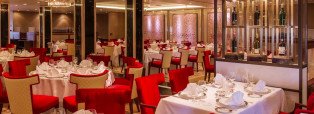
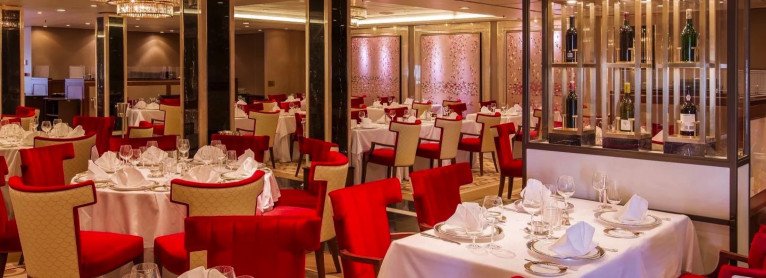
The pinnacle of fine dining at sea, exclusively for guests staying in our Queens Grill Suites.
Drawing inspiration from the world’s finest kitchens, the Queens Grill restaurant offers a true taste of fine dining on board, elevated by a front of house team for whom nothing is too much trouble.
Open for breakfast, lunch and dinner daily, with a Grills Afternoon Tea served separately in the Grills Lounge, a visit to the Queens Grill always feels like a special occasion.
You’ll be dining among your fellow Queens Grill guests, with a table reserved for your exclusive use throughout your voyage. There’s no need to book. Simply arrive whenever you’re ready and your table will be waiting. You may even choose to take your meal in your suite, should you wish.
Each day introduces a coveted line-up of à la carte dishes, complemented by an ‘always-available’ menu of appetisers, entrees, and desserts, executed with exemplary flair and finesse.
Alternatively, opt for one of our chef’s speciality sharing dishes (orderable in advance at breakfast or lunchtimes). From beef wellington to rack of lamb, the choice is truly indulgent. Each dish (along with select offerings on our menu) is finished and presented to you table-side, only heightening the sense of theatre that’s a signature of Queens Grill dining.
Dining at the Queens Grill restaurant is exclusive to Queens Grill guests and included within your Cunard fare. The restaurant operates relaxed dress by day and smart attire (jacket optional) for dinner service after 6.00pm, except on Gala Evenings when we invite you to dress in black tie.
Gluten free and vegetarian dishes are available. If you have any food allergies or other dietary requirements, please inform us by phone after booking your voyage. Find out more about dietary requirements on board.
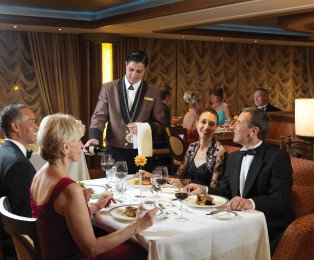
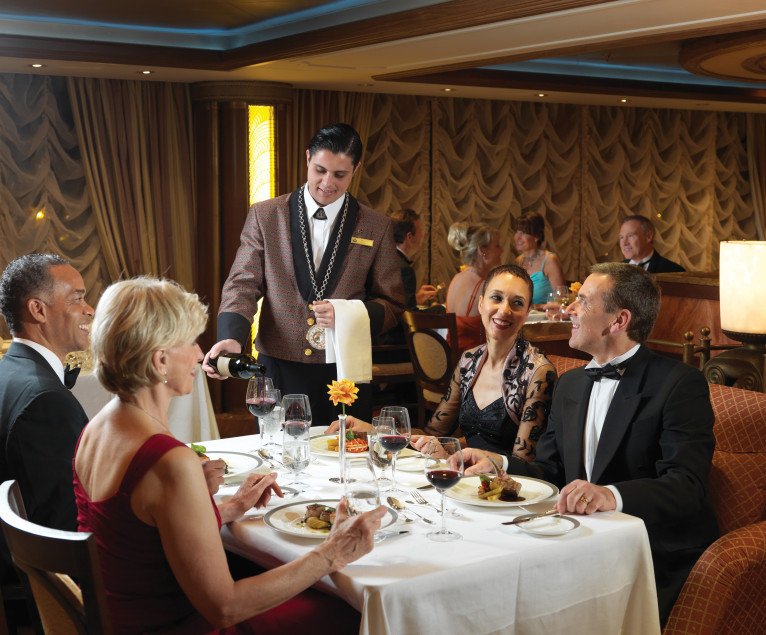
Imaginative cooking and flawless service create a dining experience fit for royalty.
For the exclusive use of guests in our Princess Grill Suites, this exquisite restaurant offers à la carte dining at an elevated level.
With a dining room to rival the world’s most luxurious hotels and a menu that showcases classical flavour pairings, creatively reimagined, the Princess Grill restaurant is among the most prestigious of our on board dining experiences. Discreet but attentive service and a raft of personal touches make every meal special.
You’ll find a comprehensive selection of continental and cooked dishes ready to rouse you each morning, whilst lunchtimes introduce a delicious four course menu alongside lighter options.
Evenings are a particularly grand affair, with the theatre of tableside serving inspiring a greater sense of occasion. Your table for dinner is reserved throughout your voyage, with no need to book; simply take your seat whenever you wish, between 6.30pm and 9.00pm.
Dining at the Princess Grill restaurant is included in your fare if you’re staying in one of our Princess Grill Suites. Relaxed dress is welcomed at breakfast and lunch, and smart attire (jacket optional) after 6.00pm, except on Gala Evenings when we invite you to dress in black tie.
Gluten free and vegetarian dishes are available. If you have any food allergies or other dietary requirements, please inform us by phone after booking your voyage. Find out more about dietary requirements on board.


Our main restaurant invites you to enjoy breakfast, lunch and dinner with a real sense of occasion.
Dining is a highlight of each Cunard voyage and the Britannia Restaurant ensures that it's unforgettable, especially on Gala Evenings. Experience a stylish and vibrant atmosphere and be tempted by freshly prepared dishes which range from twists on traditional favourites to contemporary selections. If you decide to join us here for breakfast or lunch you’ll find it traditional and relaxed, whereas at dinner this glamorous venue really sparkles.
Britannia Club guests will appreciate the more intimate surroundings of this stylish restaurant.
As you’d expect, menus change daily and in addition to the full selection from the Britannia restaurant you can savour a range of enhancements for an extraordinary dining experience.
Guests can now choose to reserve a table at any time of the evening alongside the more traditional early and late seating options.


Steaks and seafood of the highest calibre.
Do you crave an exquisite steak, seared to perfection? Or perhaps a taste of the ocean? Whether you’re in the mood for surf or turf or just somewhere extra special to dine out on board, Steakhouse at the Verandah offers just the place.
With a menu that celebrates the finest steaks and seafood throughout the world today, dining at Steakhouse at The Verandah is sure to be a culinary highlight of your voyage.
Perfect for special occasions (or just because), Steakhouse at The Verandah celebrates the best of land and sea. Buttery soft wagyu. Dry-aged Angus beef. A fruit de mer platter laden with lobster, Scottish langoustines, and Alaskan crab.
Open for lunch on sea days and dinner every evening, the exceptional menu features only the highest quality grass-fed and dry-aged beef, supplied by British butcher Aubrey Allen, whose passionate commitment to sustainable, pasture-bred, beef dates back to the 1930s. When ordering steak, not only will your choice be cooked exactly to your preference, you’ll even be presented with a selection of steak knives to choose from, each one engineered to cut effortlessly and cleanly. After all, the finest produce deserves the finest treatment.
Lunchtimes at Steakhouse at The Verandah are a relaxed occasion with an informal dress code. Expect favourites like delicate Dover sole, prepared à la meunière, or simply grilled, and house-smoked Irish short rib, cooked low and slow, with spiced coffee and almond crumb, and caramelised shallots. Should you be joining us for dinner, you’ll find the evening menu expands to include a wider steak selection and other options, such as a succulent lamb rack and jumbo grilled tiger prawns.
As with the dining menu, the Bar at Steakhouse at the Verandah showcases ingredients hailing from either side of the Atlantic. You’ll find a generous list of drinks to complement your meal, including cocktails inspired by New York and London; a nod to Cunard’s iconic Transatlantic Crossing.
Why not arrange an extra special meal during your voyage, and book a table for lunch or dinner on My Cunard prior to sailing? Or you could book on board using our digital planner, My Voyage. The cost for dinner is US$58.50 if booked pre-cruise, or US$65 if booked on board, and for lunch, US$31.50 or US$35, respectively.
Gluten free and vegetarian dishes are available. If you have any food allergies or other dietary requirements, please inform us by phone after booking your voyage. Find out more about dietary requirements on board.


Classic and continental flavour pairings bring the world to your plate.
Welcoming guests from early morning until late in the evening, these informal dining venues are like nowhere else you’ll dine at on board. Wonderfully laidback, no matter what time of day you visit, these dining experiences are anchored around buffet-style self-service, inviting you to indulge as much or as little as you like.


The Golden Lion is an authentic British pub with a great selection of beer and cider. This is complemented by a traditional pub lunch menu with favourites such as cottage pie and fish and chips


You can devote an indulgent hour each and every day to our signature Afternoon Tea.
If anything perfectly encapsulates Cunard’s service and sense of occasion, it is our prized daily ritual: Afternoon Tea, served by white-gloved waiters from 3.30 to 4.30pm every day in the Queens Room. Indulgent finger sandwiches, scones and pastries accompany Twinings fine leaf teas, as the orchestra provides a melodic backdrop. Our Grills guests may also retreat to the more intimate Princess Grill restaurant, while a more casual interpretation awaits in the Lido or King’s Court.


Enjoy delicious, freshly prepared food delivered direct to your room with our compliments.
We’re on hand 24 hours a day to bring you a delicious snack or something more substantial, whenever you fancy it. Whether it’s a lazy breakfast in bed, a tempting afternoon snack, a delicious evening burger or even a naughty midnight treat, just give us a call.
After all, exploring the world can be hungry work and you may simply fancy the convenience of dining in your own stateroom or suite. And If you’re a Grills Guest you can even order from the full Princess Grill or Queens Grill menu.


Discover new ways to learn and grow with the remarkable guest speakers and classes we host on board.
During your voyage, you may be joined by some famous faces with fascinating stories to share - perhaps a famous writer, actor or musician or possibly an eminent scientist, explorer or politician. Join one of our Cunard Insights talks to be entertained and informed by thought provoking stories, occasionally in intimate settings. You can even improve your iPad and computer skills with our i-Study Enrichment Programme.


Our renowned dance classes will help you to hone your moves, whatever your standard.
Whether you're an absolute beginner or simply keen to perfect your steps you'll love the opportunity to join the variety of dance classes on offer. Available on voyages of 7 nights or more, classes are lead by coupled instructors and include ballroom as well as Latin and line dance. And when evening falls, what better way to showcase your new moves than in the chandeliered grandeur of the Queens Room?


Express yourself with our activities for art lovers or purchase a special piece to enjoy at home.
When you experience the freedom of being at sea you'll soon realise it's the perfect time to indulge in the joys of art. You can join a range of activities including watercolour classes, talks, seminars and discussions lead by well known artists and art historians. Take time to browse the eclectic portfolio on display in the Clarendon Fine Art Gallery and choose a new addition to your collection at home. Watercolour classes are available on all cruises that have full sea days.


Wherever on earth our flagship carries you, set off on an adventure through the stars.
You know you’re on a special ship indeed when you can settle into your comfortable seat in the largest planetarium at sea. More than this, Illuminations is a luxury 3D cinema and a classical music venue. The planetarium dome can send you on an epic voyage across the solar system, teach you to navigate by the stars, or show other science and natural history films, with up to four screenings on each sea day. With the dome retracted, Illuminations hosts 3D films and stunning concerts and recitals.


Succumb to the charms of this magical, light-filled bar, with its scintillating views from the bow of your ship.
Inspired by legendary Cunard Commodores who have expertly captained our fleet over the years, this charming bar offers an ideal setting in which to enjoy an early-evening aperitif or an after-dinner nightcap.
Savour the sweeping views across the horizon as you sip on a cocktail, a classic fine wine, or a premium aged whisky, prepared with signature flair and served at your table.
Visiting at golden hour brings the promise of vibrant orange and pink-streaked sky as the sun sets over the ocean - arrive early to secure a window-side table - while clear nights may reveal a star or two glimmering in the distance.
Those stopping in before dinner will be treated to a complimentary selection of canapés with their drink; just one of many little surprises you’ll experience throughout your ship, while evenings come alive against the soothing sounds of a live pianist.
The pièce de resistance, however, is the collection of cocktails inspired by seven of our most decorated Commodores; each with its own intriguing backstory.
From the quintessential British notes of Land of Hop & Glory, inspired by Commodore Sir Cyril Illingworth, to the Commodore’s Cure, a tribute to Commodore Sir James Bisset, these unique concoctions are as legendary as the men they serve to honour.


Join us in our Monte-Carlo inspired Casino where you’ll find a winning combination of elegance and excitement.
During the day meet our expert croupiers and take the chance to learn the rules and sharpen your game.
As night falls the casino comes alive. From first flutters to high-rollers, there’s something for everyone. Unleash your daring side with our wide selection of slots and tables or simply soak in the atmosphere whilst sipping on a Cunard Martini – the choice is yours.
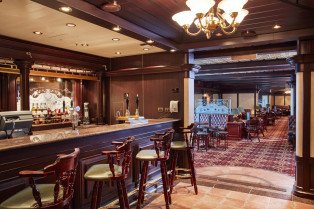

A friendly home-from-home in which to savour classic British pub fare.
With its sumptuous leather banquette seating, darts board, and occasional live sports, a visit to the Golden Lion offers all the charm, warmth, and authenticity of walking into a traditional British pub.
Dining at The Golden Lion is equally authentic, with a menu that showcases hearty and much-loved dishes enjoyed for generations throughout the UK and beyond. Food at the Golden Lion is included in your fare and alcohol is purchasable as priced.
The atmosphere at the Golden Lion is always relaxed and vibrant, with occasional live music and televised sports, complemented by lively pub quizzes and darts tournaments – an ideal way to meet new friends or put your skills to the test.
A casual dress code is observed all day long, although if you do wish to dress a little smarter in the evenings that’s perfectly fine too.


Be tempted by the classic allure and impressive drinks range of this refined cocktail bar.
You'll appreciate on your holiday that there's a bar to suit every occasion and when you require somewhere especially refined you'll love the allure of this classic venue. Through charts and cartography, the elegant menu pairs classic drinks with light canapés and snacks – and delectable Godiva chocolates.
Sample the flavours of signature specials drawing inspiration from destinations on your voyage, and when evening falls be tempted by the unique character of our 20 Zodiac themed cocktails.


Embrace the sense of occasion with every sip at this grand bar and ballroom.
With its sweeping dancefloor, double-height ceiling, and glittering chandeliers, a visit to the Queens Room can’t fail to evoke the timeless romance of ocean travel.
Guests who sail with Cunard frequently have come to regard it as the social hub of the ship, and on Gala Evenings especially this elegant bar and ballroom offers a truly magical setting in which to be swept away in the spirit of the occasion.
It’s also where we serve our signature Afternoon Tea at 3:30pm each day. Just follow the soothing tones of the string quartet and the unmistakable scent of our chefs’ freshly baked scones. Then there’s the chance to brush up on your dancing or learn a new skill. From fencing to Argentine Tango, the Queens Room sets the stage for all kinds of activities.
It’s at night however that this elegant ballroom truly comes alive; no more so than on Gala Evenings (our famed black tie nights) when a live orchestra fills the air with music as guests take to the dancefloor in their finest eveningwear. Drink in the atmosphere from your table with a glass of champagne, or a speciality cocktail, and savour the chance to step out in style for one special night of indulgent celebration.


Join us here by day for a range of inspiring activities or as night falls for music and dancing.
Blessed with exceptional views, the Yacht Club on Queen Victoria and Queen Elizabeth hosts many entertaining events. Join us here by day and return later to dance under the glow of the evening stars. As evening approaches, jazz fans in particular may find themselves here as the Yacht Club transitions into a lively pre- and post-dinner venue with superb live jazz. Later that evening those who love to party will relish the fact that the resident DJ and dance band play late into the night.


You'll find this airy lounge is flooded with daylight and is always relaxing at any time of day.
On board Queen Victoria, close to the pool and Lido buffet, this is the place to experience a more informal atmosphere until late in the evening. Floor-to-ceiling windows allow sweeping views from this comfortable and relaxing venue.


Take inspiration whilst on holiday and immerse yourself in the largest book collections at sea.
For many, a good read is an essential part of a relaxing holiday and there's no better time to indulge this passion than whilst on board with us. You'll find the range of titles available in our beautiful libraries is as impressive as the refined surroundings.
So, find yourself a good book, pull up a leather armchair and enjoy some quiet contemplation. You may even wish to join the Cunard Book Club where thought provoking literary discussions with fellow guests are led by the ship's librarian.


Experience the thrill of a vibrant music and dance extravaganza in our full sized theatres.
You'll find our elegant Royal Court Theatres as impressive as any in the West End or Broadway and they're the perfect setting for you to enjoy invigorating, high-tech dance productions. We're constantly introducing new shows performed by our highly talented Royal Cunard Singers and Dancers. Popular recent productions including the cutting-edge dance shows 'La Danza' and 'Rhythm of the Night,' which takes audiences on a magical journey through the sights and sounds of Latin America.

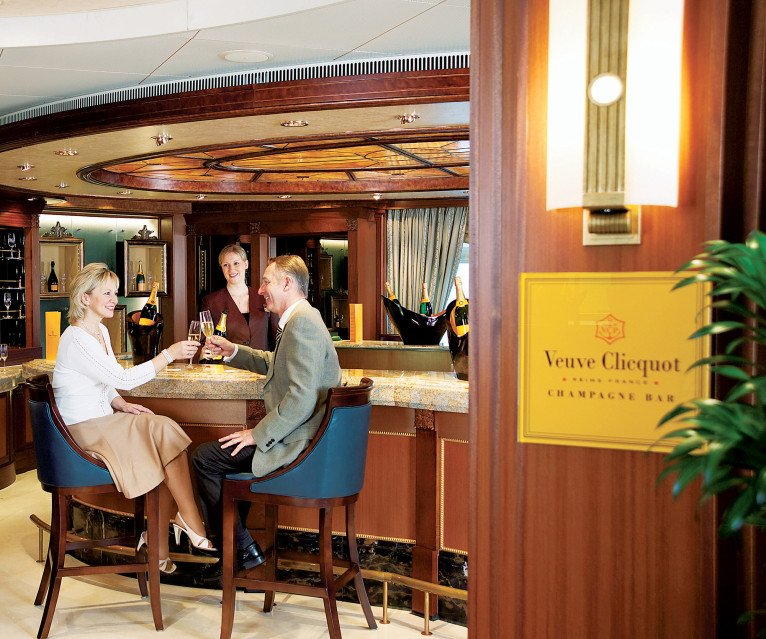
You'll find our elegant Champagne Bar the perfect venue to enjoy delicious premium Champagne.
Cunard is proud to offer guests a comprehensive collection of Laurent-Perrier's premium champagnes across the fleet.


A relaxing venue offering light bites by day and small plates with entertainment in the evening.
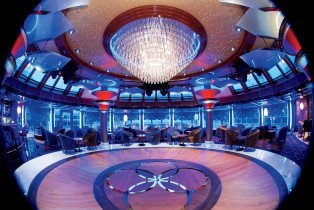
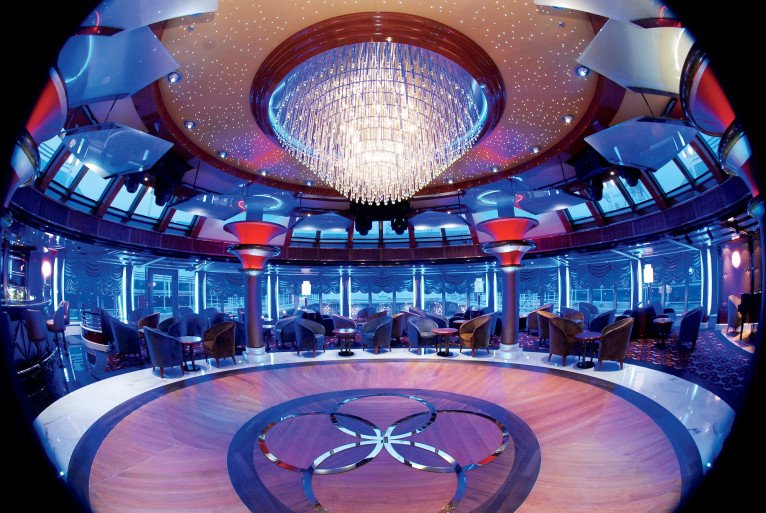
By day admire the expansive panoramic views that stretch from horizon to horizon, and by night dance to the beat of the big band and DJ. All set under the splendid glass-domed roof of this stunning contemporary nightclub.


Art connoisseurs can enjoy a choice of three galleries. Cladendon Fine Art features original artwork and lithographs by 20th and 21st century artists. Cunardia and Cunarder’s Gallery each focus on artefacts from past Cunard lines, black and white photography of famous faces and stories of those who have travelled with Cunard over the years.


Elegant boutiques on board offer exceptional fashion and luxury accessories, books, fine art and more.
Savour the chance to indulge in a little retail therapy on board at our high-end boutiques, with opportunities to find the perfect souvenir for loved ones at home, or perhaps a little something for yourself. Find luxury brands offering jewelery, watches, fashion, perfume, and makeup. Well-known names you can expect to see include Clinique, Radley, Michael Kors, and Clogau Gold.
Find a wide selection of Cunard merchandise to act as a keepsake or gift upon your return home. Whether it’s a cuddly toy for a little one, or perhaps a warm Cunard fleece, choose from a range of accessories and mementos that will forever remind you of your voyage.
The on board bookshop is another favourite, with shelves brimming with a mix of fact and fiction including nautical literature, posters, and other memorabilia. Perhaps you’re looking for an easy read to get lost in during your holiday, or do you want to learn more about the Cunard Commodores of years gone by? Our helpful staff are on hand to help you find what you’re after.
Meanwhile, in Clarendon Fine Art Gallery, be inspired by the rotating collection of classic and contemporary artworks and maybe purchase a masterpiece of your own. Find out more about shopping at the art gallery. You may prefer to own a piece that’s a little more personal, in the form of a photograph of you and your loved ones taken by the professional photographer on board. You can browse your photos in the gallery throughout your voyage.
There may be retail events taking place during your voyage, from special sales and discounts to talks about specific products. Check your Daily Programme to stay up to date with everything happening on board.
When it comes to purchasing any essentials you may be in need of, you’ll be able to find a helpful range on board. This includes things like shower gel, deodorant, feminine hygiene products, hair care, and oral hygiene products.


Churchill's Cigar Lounge is located on deck 10.


Games enthusiasts will take pleasure in the compelling selection of games to enjoy.
Doing what you enjoy most really defines the Cunard experience and games enthusiasts will love every minute. Options range from popular board games to traditional favourites such as cards, Mahjong, backgammon and chess - or you may prefer a game of darts in the Golden Lion pub. On sea days join us for Bridge lessons with expert tuition for beginners and improvers. Alternatively, the many social games held on board such as pub quizzes are a great way to meet (and challenge!) new friends.




Sit back and listen to some of your favourite music or discover new compositions at one of our classical concerts.
On every sea day you will find a classical recital to indulge in. With a wide variety of talented guest musicians, each voyage is sure to delight with new and varied programmes.

Discover a sanctuary of relaxation that takes inspiration from the oceans on which our ships sail.
Welcome to Mareel Wellness & Beauty, available on Queen Mary 2, Queen Elizabeth and Queen Victoria. A space far away from the stresses and strains of the everyday, with experiences that refresh and transform.
Mareel Wellness & Beauty takes inspiration from the oceans on which our ships sail to indulge your senses—mind, body and soul. We invite you to relax, enjoy renewed energy, improved health and appearance with comprehensive spa, beauty and fitness facilities on board.
The Mareel Spa is available on all our ships and offers a range of ocean-inspired massage, body, facial and alternative treatments that transform and heal. Our Aqua Therapy Centre provides a unique water environment for guests to explore including a Thermal Suite, Hydrotherapy Pool and Relaxation Area. Access to the Aqua Therapy Centre is available with a single or multiday pass.


With a fully equipped gym on board each of our ships, and exercise classes guided by expert instructors, you don’t have to abandon your fitness regime when you holiday with us.
Whether you like to ease into your morning with an early gym session or round off the day at a yoga class, the fitness facilities on board our ships mean you can always nurture your health and wellbeing - no matter where in the world you sail.
Please note that use of the gym is included in your voyage fare, however personal training sessions, consultations, and fitness classes may be subject to additional charges.
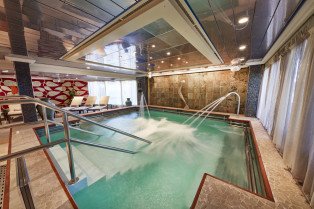
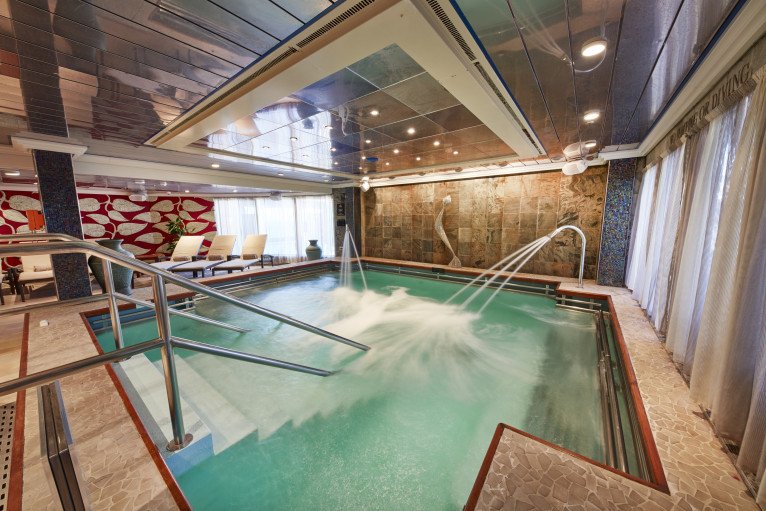
Indulge in a refreshing dip in one of the several pools and whirlpools on offer.
Whichever ship you decide on you can choose from a refreshing variety of pools and whirlpools - each heated to just the right temperature. Queen Mary 2 offers two outdoor pools and her Pavilion Pool has a retractable roof so you can enjoy a dip whatever the weather. In addition, there's the Minnows Pool for kids and her luxurious Spa Pool is a treat. Queen Victoria and Queen Elizabeth on the other hand offer 2 spacious outdoor pools as well as a hydrotherapy pool in their spas.


Sports enthusiasts will feel right at home on our ships, whether taking part or just watching.
There are many ways to keep yourself active on our ships. A few laps of the Promenade Deck and the games of shuffleboard and deck quoits have been pastimes for almost as long as we have been sailing. You’ll find pursuits like table tennis, paddle tennis, golf putting and swimming too. For armchair sports fans, Sport24 offers coverage of major events including the Premier League, Wimbledon, Formula 1, the Ryder Cup and more, shown in certain bars and lounges, and all staterooms and suites.

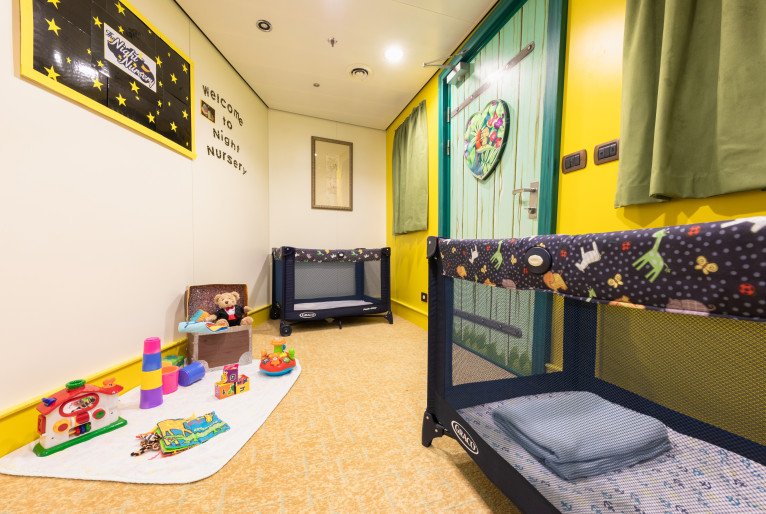
Enjoy your holiday even more, knowing that your little ones have a safe place to sleep each evening.
There's a great sense of freedom to be had when you can enjoy drinks, dinner or a show knowing that your little ones are sleeping soundly. Available on a first come first served basis, our free of charge Night Nursery equips you with a pager so we can contact you if need be or, if you let us know your plans, we'll come and find you. For that extra peace of mind professional childminders are on hand. Suitable for children aged 6 to 23 months and open from 6pm to 11pm.
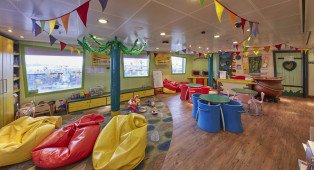
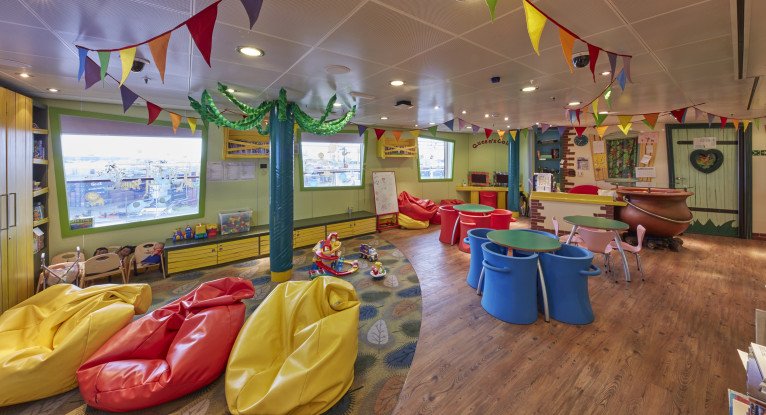
Children aged 2 to 7 will love the activities and themed days in this supervised haven.
The Play Zone is a fully supervised play area which younger members of your family will just love. They're sure to have a fun-filled holiday with the structured activities provided by our fully trained Youth Team - including themed days, arts and crafts, games, books, puzzles, toys and computer games. There's even a sheltered outdoor play area with a range of play equipment such as cars and tricycles. Infants from 6 months to 23 months are welcome to join in the fun, with parental supervision.
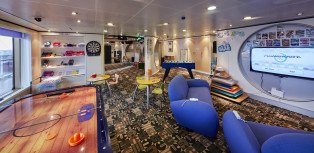
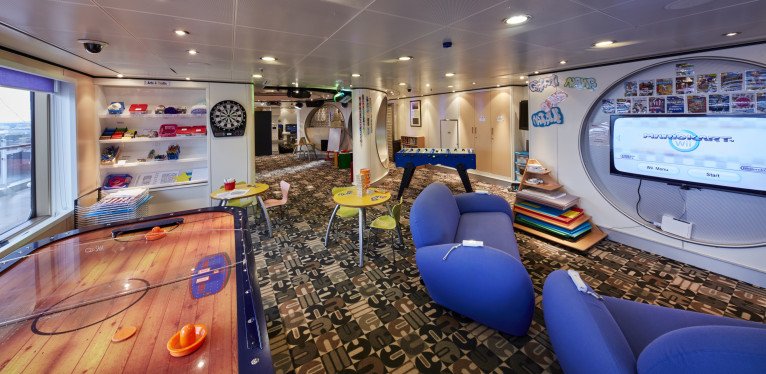
The varied activities running here throughout the day are just the thing for 8 to 17 year olds.
Kids aged 8 to 12 will experience the time of their lives with the games and activities available in this dedicated area. Our Youth Team provides the supervision and organises events so that each action-packed day has something for everyone including sports, arts and crafts, friendly challenges and, of course, games consoles. Note that the exact age groupings will depend on the number of children travelling on any particular voyage.
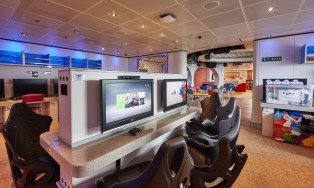
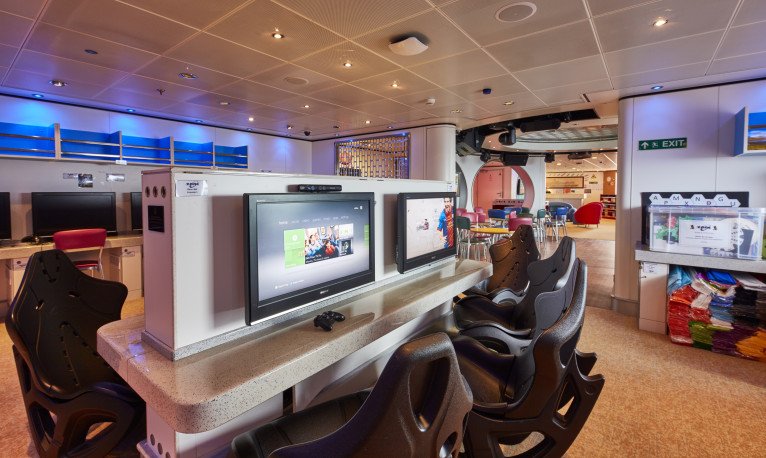
Teenagers 13 to 17 will have a great time with the sports, discos and games we run around the ship.
Teens in your party will have a whale of a time in this dedicated club for 13 to 17 year-olds. They can enjoy deck sports, discos, gaming consoles, quizzes and much more - ensuring an action-packed holiday. They'll also appreciate the special Teen Zone area where they can challenge each other to the latest video games as well as the table tennis tournaments and team games we organise. Note that the exact age groupings will depend on the number of children travelling on any particular voyage.
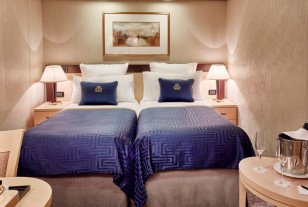
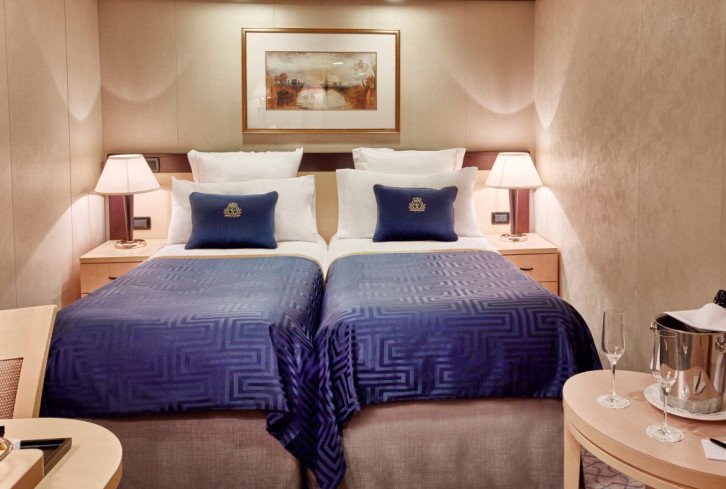
Approximately 152 sq. ft.
With a variety of locations to choose from on board, our well-appointed Britannia Standard Inside staterooms are a haven of comfort and style to enjoy during your voyage. You’ll find thoughtful features and luxurious amenities, all organised by your dedicated steward to ensure you are always attentively looked after.
Each Britannia Standard Inside stateroom includes:
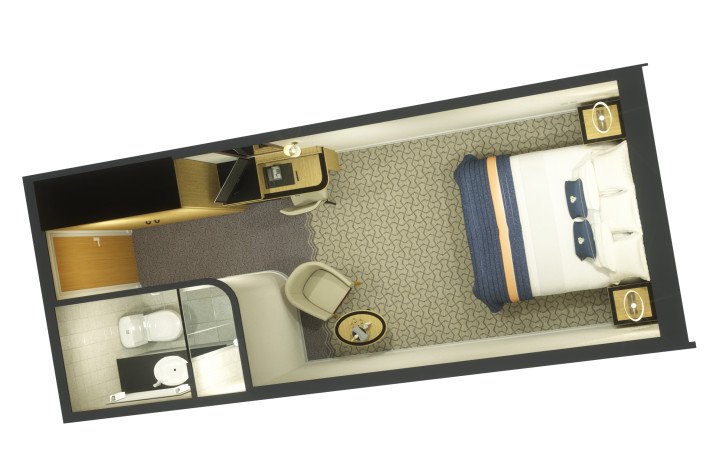
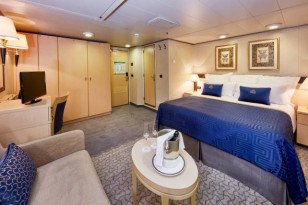

Approximately 200-243 sq. ft.
With a variety of locations to choose from on board, our spacious Britannia Deluxe Inside staterooms are a haven of comfort and style to enjoy during your voyage. You’ll find thoughtful features and luxurious amenities, all organised by your dedicated steward to ensure you are always attentively looked after.
Each Britannia Deluxe Inside stateroom includes:
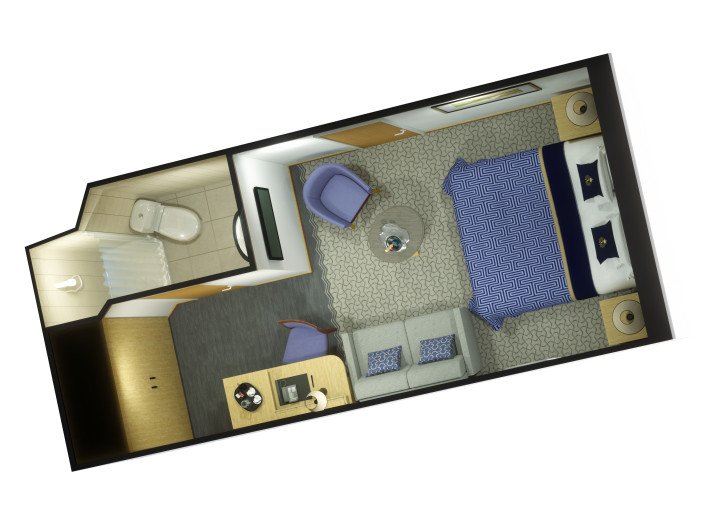
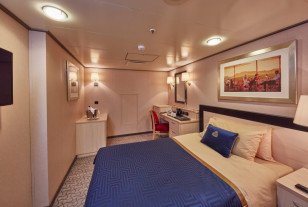
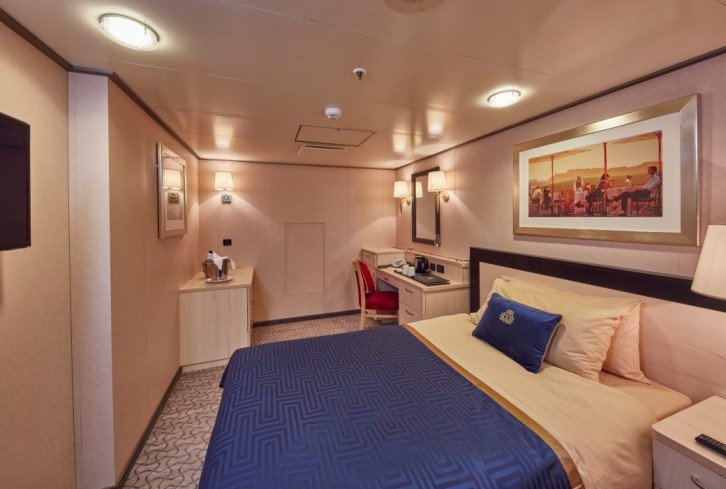
Approximately 159 sq. ft.
Our spacious Britannia Single Inside staterooms are a haven of comfort and style to enjoy during your voyage. You’ll find thoughtful features and luxurious amenities, all organised by your dedicated steward to ensure you are always attentively looked after.
Each Britannia Single Inside stateroom includes:

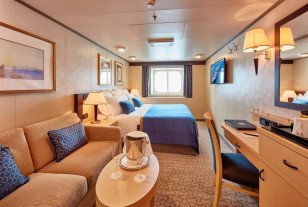
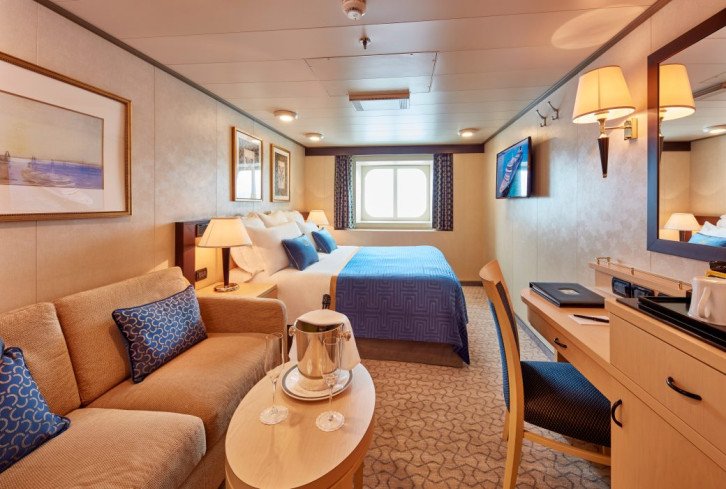
Approximately 197-201 sq. ft.
Positioned to offer sea views, our Britannia Oceanview staterooms provide a private enclave from which to watch the world go by. Perfectly framed views are the backdrop to thoughtful features and luxurious amenities, all organised by your dedicated steward to ensure you are always attentively looked after.
Each Britannia Oceanview stateroom includes:
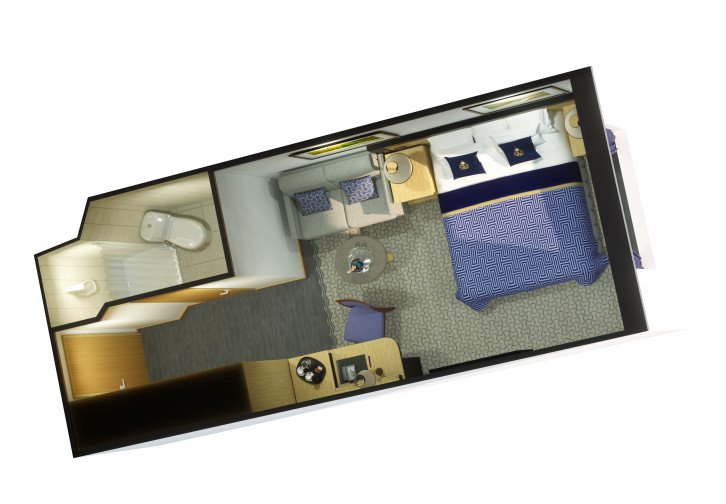
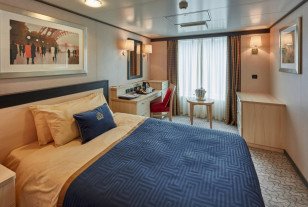
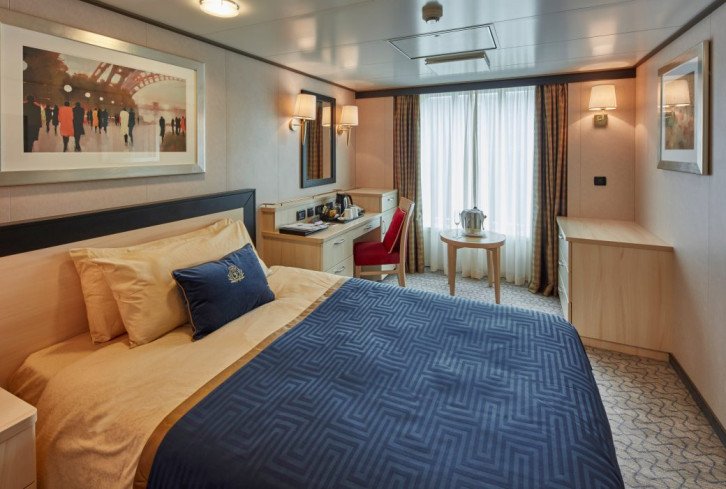
Approximately 133-168 sq. ft.
Positioned to offer sea views, our Britannia Single Oceanview staterooms provide a private enclave from which to watch the world go by. Perfectly framed views are the backdrop to thoughtful features and luxurious amenities, all organised by your dedicated steward to ensure you are always attentively looked after.
Each Britannia Single Oceanview stateroom includes:
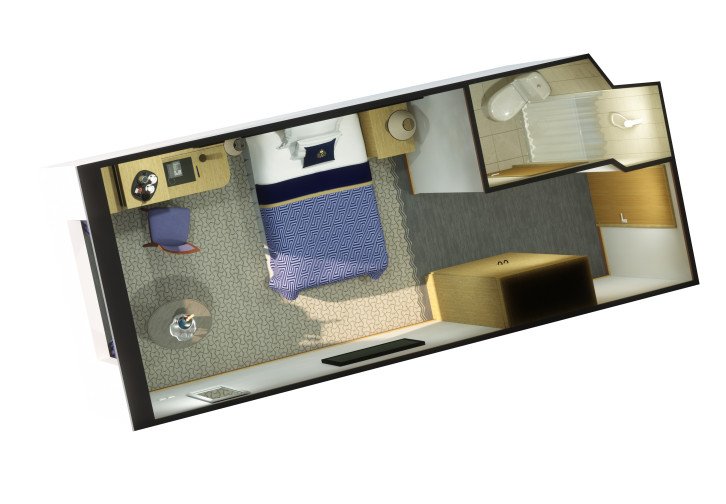
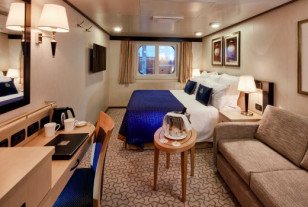

Approximately 228-408 sq. ft.
Enjoy access to private, outdoor space in one of our obstructed view Britannia Balcony staterooms. You’ll find thoughtful features and luxurious amenities, all organised by your dedicated steward to ensure you are always attentively looked after.
Each Britannia Balcony (obstructed view) stateroom includes:



Approximately 254-470 sq. ft.
Take advantage of prime sea views from your own private, outdoor space in one of our Britannia Club Balcony staterooms. You’ll find thoughtful features, luxurious amenities and benefits, all organised by your dedicated steward to ensure you are always attentively looked after.
Each Britannia Club Balcony stateroom includes:
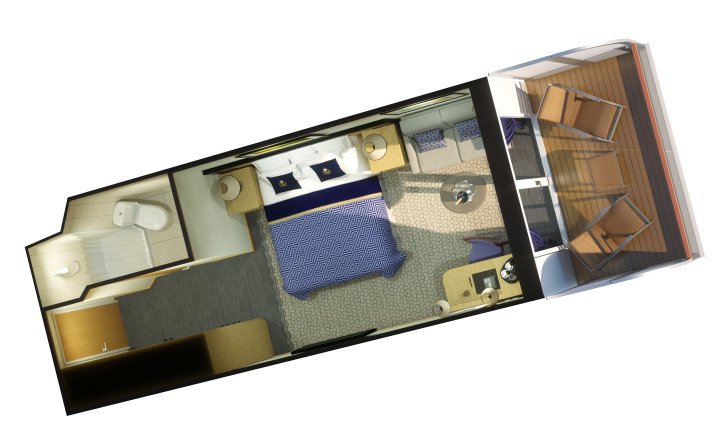
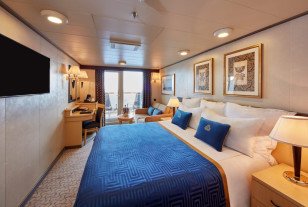

Approximately 228-472 sq. ft.
Drink in sparkling sea views from your own private, outdoor space in one of our Britannia Balcony staterooms. You’ll find thoughtful features and luxurious amenities, all organised by your dedicated steward to ensure you are always attentively looked after.
Each Britannia Balcony stateroom includes:

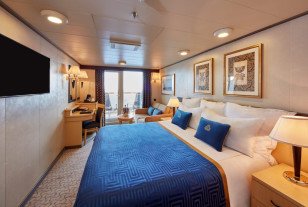
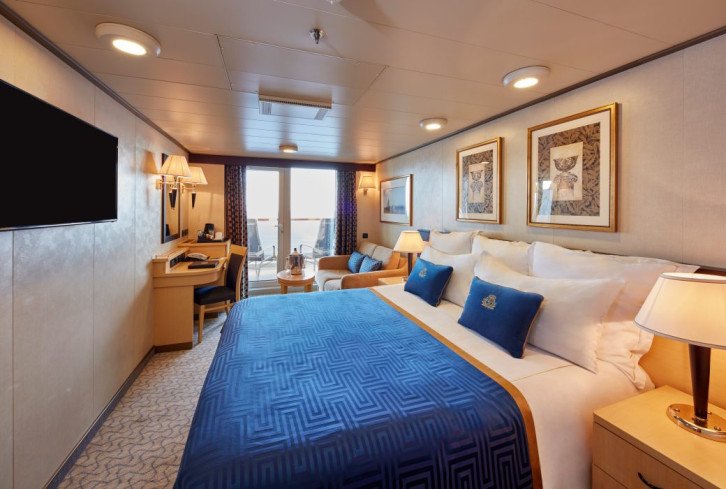
Approximately 228-408 sq. ft.
Enjoy access to private, outdoor space in one of our obstructed view Britannia Balcony staterooms. You’ll find thoughtful features and luxurious amenities, all organised by your dedicated steward to ensure you are always attentively looked after.
Each Britannia Balcony (obstructed view) stateroom includes:

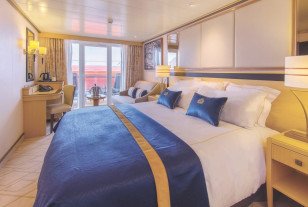

Approximately 228-408 sq. ft.
Enjoy access to private, outdoor space in one of our obstructed view Britannia Balcony staterooms. You’ll find thoughtful features and luxurious amenities, all organised by your dedicated steward to ensure you are always attentively looked after.
Each Britannia Balcony (obstructed view) stateroom includes:
Choice of Early, Late, and Open Dining in the Britannia Restaurant.
Private balcony (obstructed view) with seating.
Lounge area with seating.
Cunarder bed configurable to king-size or two single beds.
Bathroom with walk-in shower.
Satellite TV with movie and music channels.
Feature vanity and desk with hairdryer.
UK, USA and European power sockets.
Penhaligon's toiletries.
Bathrobes and slippers.
Tea and coffee making facilities.
Welcome sparkling wine.
Complimentary room service menu.
Mini-bar packages available for purchase.
A dedicated steward to keep your stateroom in fine order day and night.
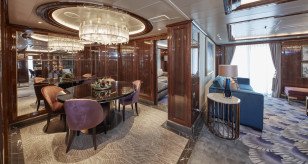
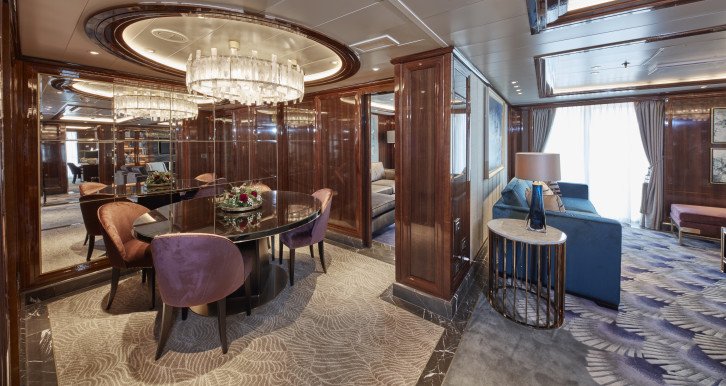
Approximately 1319-1555 sq. ft.
Retreat to an exclusive world of luxury with your own private residence at sea. Striking interior designs bring each space in your suite to life, indulging your senses with a rich tapestry of colours, materials, and art. An attentive butler is on hand at all times to truly customise your voyage experience.
The Queens Grill Grand Suite includes:
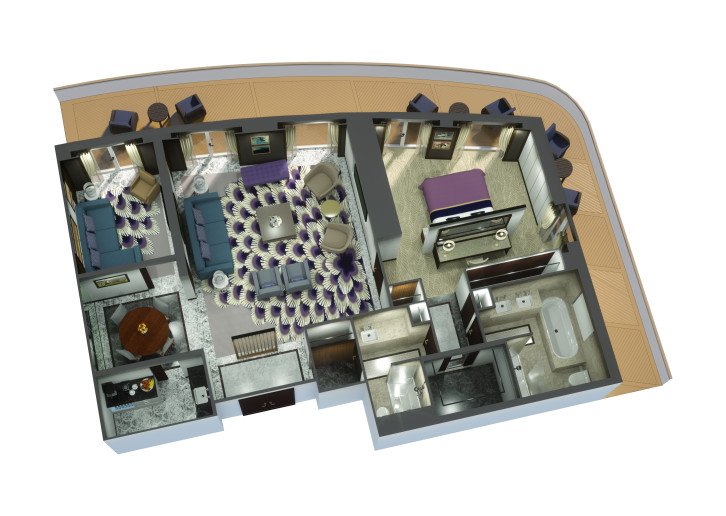
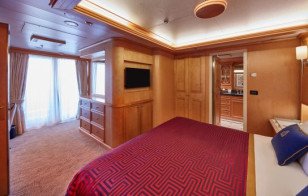
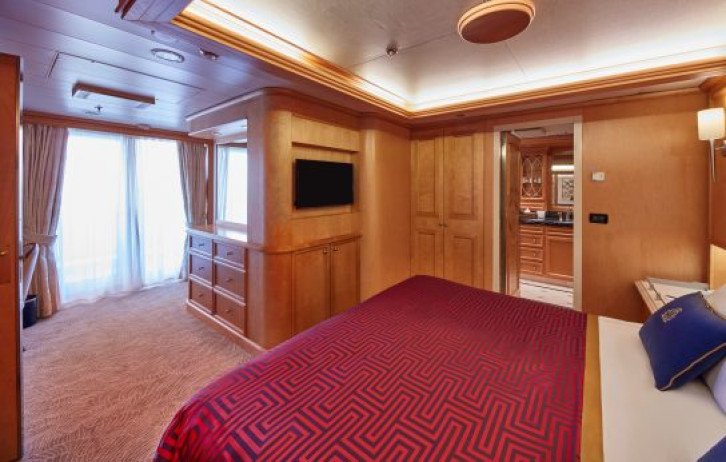
Approximately 1100 sq. ft.
Retreat to an exclusive world of luxury with your own private residence at sea. Bold Cunard accent colours and thoughtful designs bring each space in your suite to life. An attentive butler is on hand at all times to truly customise your voyage experience.
Each Queens Grill Master Suite includes:

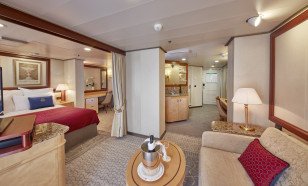

Approximately 484-596 sq. ft.
Retreat to an exclusive world of luxury with your own private residence at sea. Bold Cunard accent colours and thoughtful designs bring each space in your suite to life. An attentive butler is on hand at all times to truly customise your voyage experience.
Each Queens Grill Penthouse Suite includes:

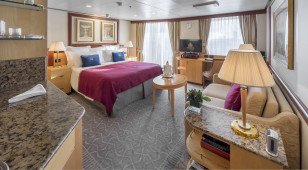
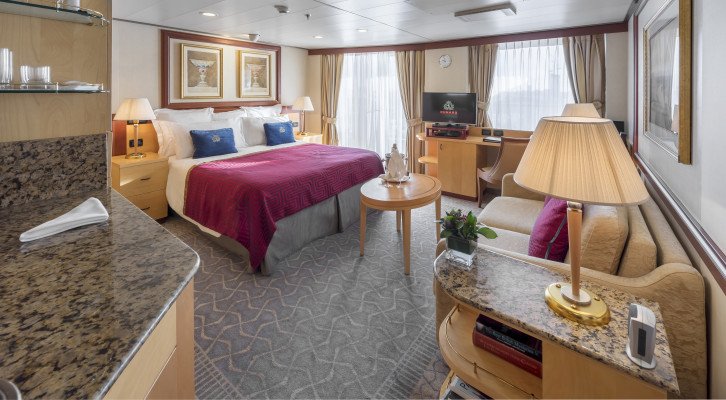
Approximately 484-757 sq. ft.
Retreat to an exclusive world of luxury with your own private residence at sea. Bold Cunard accent colours and thoughtful designs bring each space in your suite to life. An attentive butler is on hand at all times to truly customise your voyage experience.
Each Queens Grill Suite includes:

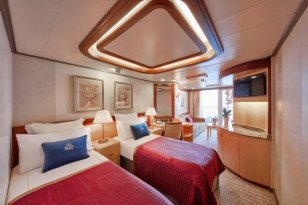
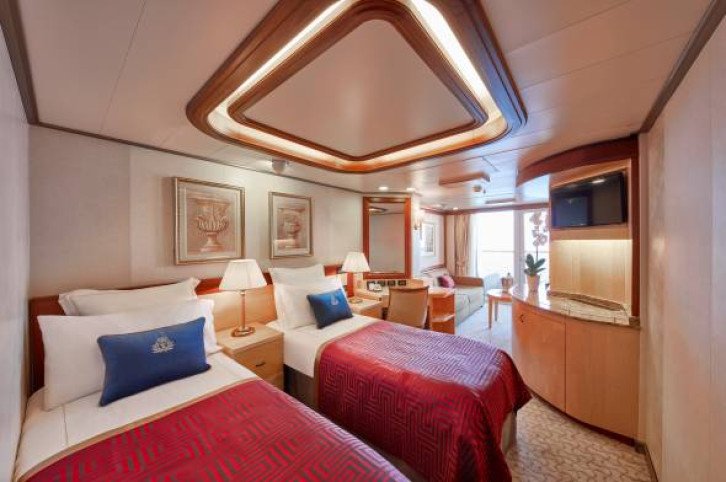
Approximately 335-513 sq. ft.
Delight in a prime location on board with sea views that can be enjoyed from both in and outside your Princess Suite. You’ll find thoughtful features and luxurious amenities, all organised by your dedicated steward to ensure you are always attentively looked after.
Each Princess Grill Suite includes:
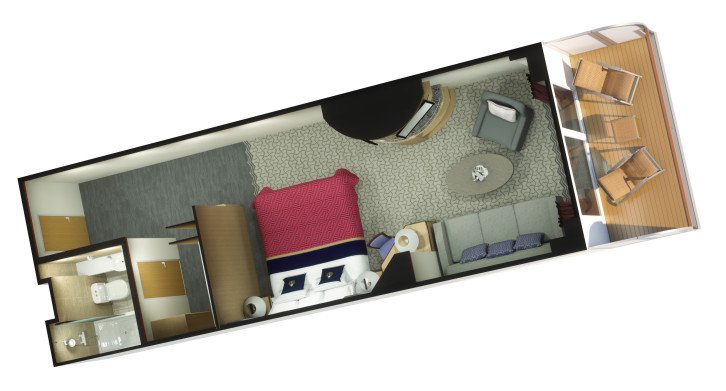
-large_thumb.jpg)







-large_thumb.jpg)







Have you found your dream cruise, or do you want to talk to us to help you choose the right cruise for you at the best price? Request a call back from our expert cruise concierge and we’ll get in touch at a time to suit you.
If you would like to contact our service team, you can select a service call back below.
If you request a call back for now we’ll get back to you within 15 minutes, we’ll be calling you from 0161 333 4459 so you can recognise our call.


